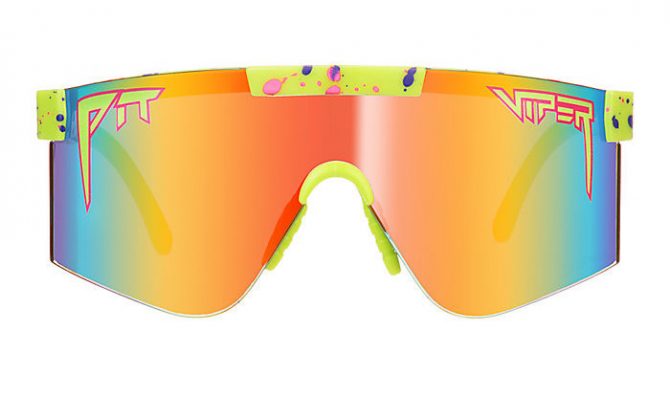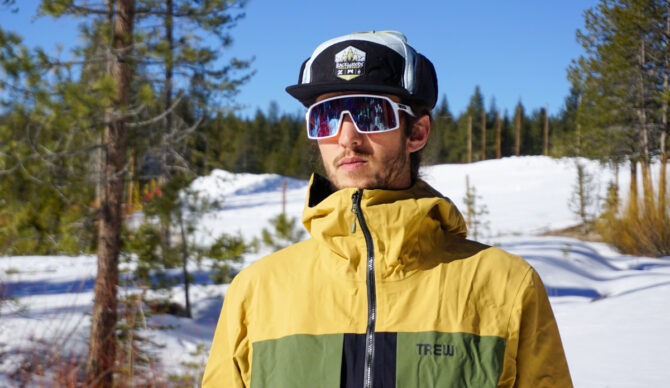
Our top choice for 2025/2026, the Oakley Sutro blends functionality and versatile style. Photo: Ken Cox//The Inertia
Eye protection is vital when out on the slopes. UV rays, snow glare, ice chips, and more provide plenty of potential dangers for what’s arguably your most important pair of sensory organs. While sunglasses don’t offer the full storm-skiing, powder-bashing protection of goggles (some options on this list get really, really close), ski sunglasses can be a fun and stylish choice for bluebird days on the resort, backcountry adventures, the aprés-ski scene, and so much more.
We got our hands on the highest-performing and most stylish ski sunglasses on the market and gave them a run for their money to help you stay informed. Our favorite overall ski sunglasses for its great coverage and versatile styling is the Oakley Sutro, but if price isn’t a concern, the POC Devour Glacial has a slew of ski-specific features. If you came here looking for something more like traditional glacier glasses, we’re huge fans of the Smith Venture.
Ski sunglasses are as much about style as they are about performance, so we did our best to provide as many different-styled options as we could, and we’re continually testing the latest and greatest to keep this article up-to-date. If our top picks aren’t speaking to you, keep scrolling for more great options.
Navigate To: Comparison Table | How We Tested | Buyer’s Guide
Related: Best Ski Jackets | Best Snowboard Goggles | Best Sunglasses | More Winter Reviews
Editor’s Note: In our most recent update, we adjusted our top pick rankings, removed a style that no longer represents our top picks, and added some more options to our Honorable Mentions section, including a callout on some particularly steezy styles from Pit Viper.
The Best Sunglasses for Skiing and Snowboarding
Best All-Around Ski Sunglasses: Oakley Sutro
Best Upgrade Ski Sunglasses: POC Devour Glacial
Best Glacier Glasses: Smith Venture
Best Budget Ski Sunglasses: Goodr Wrap G
Best Value/Most Versatile Ski Sunglasses: Sunski Tera
Best For Aprés: Pit Viper Flip-Offs
Jump To: Best of the Rest | Honorable Mentions
Best All-Around Ski Sunglasses
Oakley Sutro ($203)
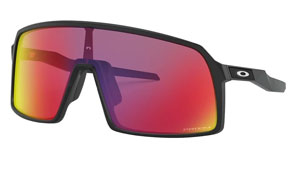
Fit: Large
Swappable Lenses: No
Lens Tech: Prizm
Pros: Large but stylish, full shield-style lens provides great coverage, multisport/everyday use appeal
Cons: No ski-specific features
Whether you’re biking or skiing, you’re likely to see the Oakley Sutro sunglasses on someone’s face. With a wide, protective lens and classy styling, these are some of the best-looking shield-style sunglasses on the market, equally at home out in the backcountry and on city streets. Lightweight and fairly durable-feeling, while they don’t benefit from most of the ski-specific features we see on the POC Devour or Smith Pursuit, their versatility for everyday wear is hard to beat, and they cost a full $100 less. They do hang on to the most important ski-specific feature, however, making use of Oakley’s Prizm technology, they provide high contrast to help filter out flat light and enhance contrast to better see snow and terrain below you.
If you’re looking for a pair of sunglasses that provide great on-the-mountain coverage while still being able to pull casual-use duty, the Sutro is where it’s at. However, shield-sunglasses aren’t for everyone, so if that’s you, but you do crave that on/off-mountain versatility, the Smith Venture, or Sunski Tera, both below, might be the choice for you. The Sutro is also available in a wide array of different styles, such as the Sutro Lite, which forgoes the bottom half of the frame to reduce weight, and the Sutro S, a scaled down version for smaller faces. There is also a wide variety of tints to choose from to optimise how much light you want to let in.
CHECK PRICE ON BACKCOUNTRYBest Upgrade Shield-Style Ski Sunglasses
POC Devour Glacial ($300)
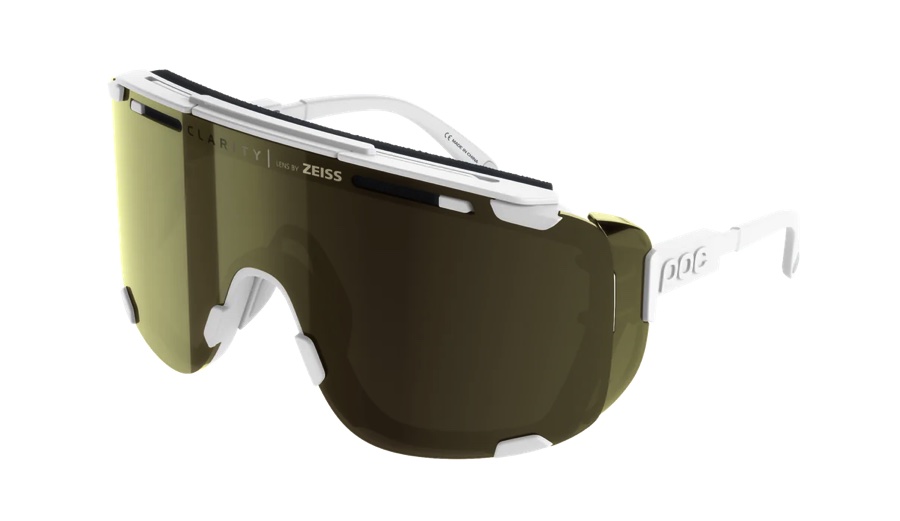
Pros: Swappable lenses, great extra (and removable) coverage at the brow and temples
Cons: Expensive, large fit isn’t for everyone
Fit: Large
POC’s Devour Glacial sunglasses come as close to a pair of goggles as you can get in a pair of sunglasses, making them a great choice for skiers who don’t want to sacrifice performance. The wide lens, combined with removable panels at the brow and temples, provides some of the best coverage we’ve tried. Best of all, due to the curve of the lens, the side shields do not impinge on peripheral vision as they often do with glacier-glasses styles. Out of sight, out of mind.
POC’s Zeiss lenses provide great clarity, but we preferred Smith’s ChromaPop technology for low/flat light. The brow panel is a great, goggle-inspired addition, resting against the forehead with a comfortable foam backer to protect against sun and snow. And they look good, too, especially (in our opinion) with the mirrored lens. That said, they are fairly large, and not super streamlined – while the chunky style is a perfect fit for the aprés-scene, they wouldn’t be our first choice for around-town use outside of the mountains. There are a ton of shield-style sunglasses out on the market these days, made for speed sports like skiing, biking, running, and more. If the Devour Glacials aren’t speaking to you, read on for more options.
CHECK PRICE ON BackcountryBest Glacier Glasses
Smith Venture ($237)
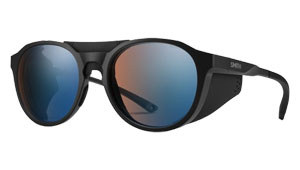
Fit: Medium
Swappable Lenses: No
Lens Tech: Smith Chromapop, photochromic available ($257)
Pros: Stylish glacier glasses that easily transition to regular sunglasses when needed
Cons: Frames don’t wrap the face as much as other styles, reducing protection, can feel a bit wide for narrow faces
For the highest-performing, most versatile glacier glasses on the market, we choose the Smith Venture. Glacier glasses have been making a comeback these days. The term “glacier glasses” harkens back to the full-coverage styles used by alpinists in extreme conditions, with dark lenses and side shields to protect from ice and glare. Recently, glacier glasses have changed somewhat, with most styles featuring clip-on side shields that provide coverage when needed but can easily be removed, leaving you with a regular pair of sunglasses. The side shields do reduce peripheral vision, so these aren’t a great choice for activities like road biking or navigating crowded slopes on the resort (we also do not recommend driving with the side shields on), but for a great way to reduce glare while touring, this newfangled glacier glasses design takes the cake.
Our top pick among this new wave of glacier glasses is the Smith Venture. With Smith’s Chromapop lens technology, the removable side shields, a removable nose piece for extra protection, and a clip-on goggle-inspired retainer strap, all the bells and whistles are there to make this the last pair of ski sunglasses you’ll need to purchase. Shield-style sunglasses do provide better field of view and often overall protection, but the style is certainly not for everyone.
A close competitor of the Smith Venture is the Oakley Clifden, which is nearly identical but has a bit of a techier look, wraps the face a bit more for added protection, and has a longer retainer leash rather than the strap on the Venture sunglasses. We chose the Ventures as the Best Overall due to better build quality in the hinges, but they’re both incredible options. If you prefer a square style of sunglasses, check out the Smith Embark Glacier Glasses.
CHECK PRICE ON Smith Optics CHECK PRICE ON Backcountry
Best Budget Ski Sunglasses
Goodr Wrap G ($35)
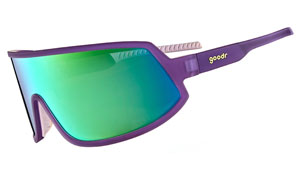
Fit: Large
Swappable Lenses: No
Lens Tech: Polarized
Pros: $35 for ski sunglasses? Yes, really
Cons: No extras, no fancy lens tech, doesn’t come with a case
Goodr is one of the newer outdoor/action-oriented sunglasses companies to hit the market, and they hit with a bang – $35 polarized sunglasses are hard to ignore, and they come in a wide array of frames and colors, from subtle to downright flashy. The Goodr Wrap G is our pick for the best budget ski sunglasses for this season, featuring a wrap-around shield-style (and polarized!) lens, plastic frame, and rubberized pads on the nose and temples to help keep things in place.
Build quality is surprisingly good; the frame has a bit of stretch to it, hugging the face nicely, and while they by no means feel premium, they do feel durable and plenty capable of taking a beating. The lenses are polarized but don’t have the same sort of snow-specific anti-glare technology that alpine styles from Smith, POC, Oakley, and others present. Overall, the biggest selling point of the Goodrs is the price. If you’re the type to lose or break sunglasses often, Goodr’s insane value is a worthy option. Another option in this budget category is the Tifosi Sanctum (also $35), which you can learn more about in our write-up of the Tifosi Sizzle, below.
CHECK PRICE ON REIBest Value/Most Versatile Ski Sunglasses
Sunski Tera ($98)
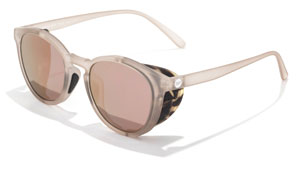
Fit: Medium
Swappable Lenses: No
Lens Tech: Polarized
Pros: Removable side shields provide extra coverage on the slopes but are easily removed for aprés/around town
Cons: Lenses are polarized but not super high-tech
Sunski’s Tera sunglasses bridge the gap between stylish sunnies and slope-ready shredders. With removable side shields to protect from sun and snow, they score well on coverage, but with a slight reduction in peripheral vision. Remove the side shields, and you have a perfect pair of everyday sunglasses in a classic round-lens design, making these sunglasses incredibly versatile. If the shape of the Tera isn’t your favorite, make sure to check out the Sunski Treeline and Sunski Couloir, which come in a larger, more aviator-style frame and square frame style, respectively, with the same lens/build quality and removable side shields.
We were very impressed by the lens technology these guys make use of. While the tint doesn’t quite make the colors pop as much as premium lens tech from Smith, Oakley, or POC, for half the price, they do pretty well at cutting the glare. Sunski now also makes its sunglasses in a variety of VLT ratings, so you can choose a darker or lighter tint depending on your preferences. Style-wise, they look good, and that speaks for itself. Sunski, as a California (San Francisco)-based company founded in 2012, has a strong, sustainable bent to boot, making this a feel-good purchase. And as a small company, the service they give their customers is pretty unmatched among the brands we’ve tested. If you’re looking for a value pair of shield-style ski sunglasses, check out the Tifosi Moab below.
CHECK PRICE ON BackcountryBest Aprés-Style Ski Sunglasses
Pit Viper Flip Offs ($100)
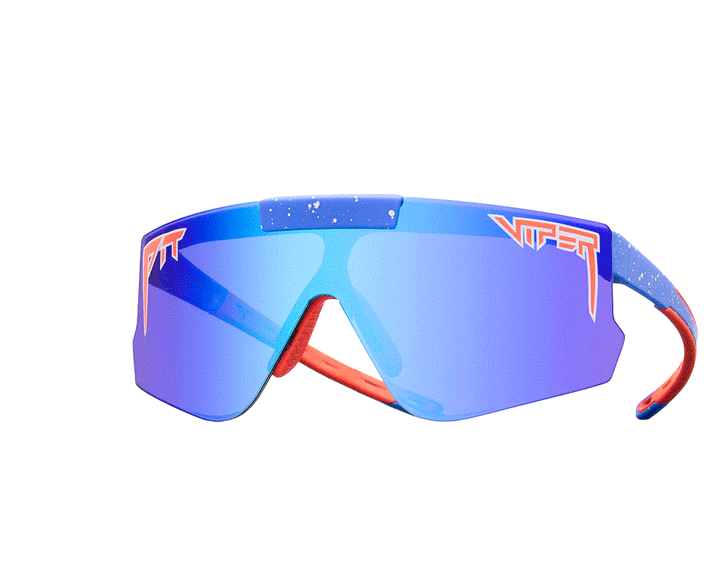
Fit: Large
Swappable Lenses: No
Lens Tech: Polarized
Pros: Pit Viper steeze, solid coverage, and durable construction
Cons: Not the most high-tech lenses
Pit Vipers and aprés go together like spring skiing and jeans. Not the most high-performance option available, but scoring high on style, with an attitude to boot. While any pair of Pit Vipers is sure to earn you some gnar points at the base lodge bar, the Flip Offs, as the name suggests, are the epitome of such a “don’t give a you-know-what” attitude, and translate well from the slopes to wherever else you might find yourself.
From a performance perspective, the Flip Offs sports a fairly wide and high-coverage lens that will keep your eyes protected from all but the powderiest of face shots, and grippy, flexible arms that keep these sunnies right where they’re supposed to be – your face. You can even attach a lanyard through the holes at the end of each arm for added security. And, if you find yourself needing a clearer view of what’s ahead, or a dramatic entrance as you stroll into the lodge, simply grab a corner of the lens and flip it, well, off. You’re sure to get a few oohs or ahhs as you do so.
CHECK PRICE ON AMAZONOther Ski Sunglasses We Love
We’ve tried a lot of ski sunglasses over the years, and above is just a smattering of our favorites. Below are some other options that we tested and found to be awesome.
Runner-Up Best Value (Shield-Style) Ski Sunglasses
Tifosi Moab ($80)
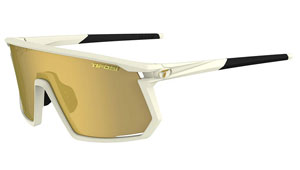
Fit: Large
Swappable Lenses: Yes
Lens Tech: Tifosi Clarion, photochromic available
Pros: Great coverage, photochromic lenses provide great versatility in varied light conditions
Cons: Ventilation slits are more suited to biking than skiing
Photochromic lenses used to be hated on as a gimmicky marketing term. And they were, at least before the technology got as good as it is today. It used to be that photochromic lenses were either too dark or too light to truly cover the wide range of light conditions you might get out there in the world, and the transition time for the lenses to change tint was unmanageably slow. That’s no longer the case, and the Tifosi Moab sunglasses are a perfect example.
The lenses on these guys can transition from 14-74% VLT (Visual Light Transmission, scroll to the end for a breakdown on that critical term), good enough for everything from bright sun to night skiing. And in a world of $200-plus sunglasses, the $80 price point is a refreshing reminder that you don’t need to shell out the big bucks for high-quality optics. Our only ding is that the ventilation cut-outs at the brow and temples are great for warmer-weather activities, but for skiing, let a bit more air in than we’d like. The sunglasses fit on the larger side. For a slightly narrower version, check out the Tifosi Sledge.
CHECK PRICE ON BackcountryAnother Great Shield-Style for Multisport Use
Smith Wildcat ($247)
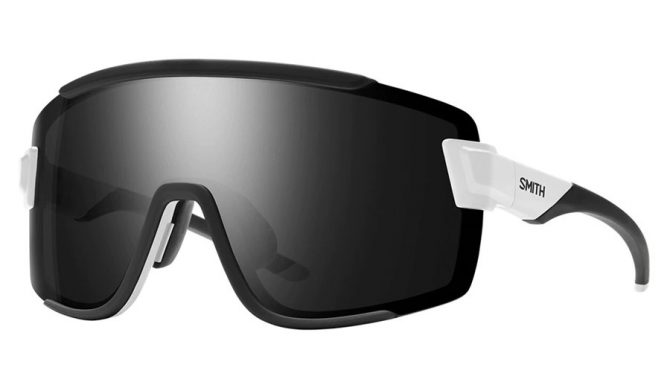 Fit: Medium
Fit: Medium
Swappable Lenses: Yes
Lens Tech: Smith Chromapop, photochromic available ($277)
Pros: Swappable lenses, nice, albeit bulky, hard case
Cons: Lens-swapping is a process, especially with cold fingers
The Wildcats are one of Smith’s most popular action-sports sunglasses, suited to snow sports and really anything you set your mind to. If you plan on going fast, these are an awesome choice. Coverage is great with a wrap-around lens style and a minimalist frame that does little to obstruct your view.
There aren’t any snow-specific extras, but the sunglasses are equipped with Smith’s Chromapop lenses, which make a huge difference over regular polarized sunglasses when on the snow. Photochromic options are available, but we were also impressed with how well the Chromapop Black lens we tested (VLT 10 percent, Smith’s darkest tint) handled shade as well as sun, and the included clear lens is great for night skiing or extreme low-light conditions.
What pushed these sunglasses further down our picks, was
CHECK PRICE ON SmithCHECK PRICE ON Backcountry
Runner-Up Best Glacier Glasses
Oakley Clifden ($297)
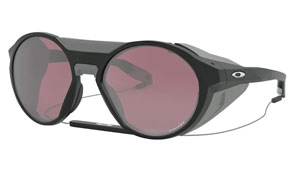
Fit: Medium
Swappable Lenses: No
Lens Tech: Prizm
Pros: Great coverage, frame wraps face nicely and seals out the elements
Cons: Expensive, hinges feel cheap
Oakley’s Clifden is an awesome lightweight pair of glacier glasses with a nice set of extras and Oakley’s Prizm lenses. The frame wraps the wearer’s face nicely, really sealing the eyes against wind, snow, and harsh sunlight with removable side shields and a removable nose piece. The sunglasses come with a lightweight retainer cord that clips onto the end of each arm and lets you hang the sunglasses around your neck when not in use. It’s also worth mentioning Oakley’s Prizm lenses, which are some of the best in the game for enhancing detail on the snow.
It was a tough call between the Clifden and Smith’s Venture glacier glasses. While we prefer the fit of the Clifden, we were a little underwhelmed by the build quality, with plastic hinges that didn’t feel very durable. At the time of publishing, the Clifdens are also out of stock almost everywhere, so with these considerations in mind, we went with the Smith Ventures for Best Glacier Glasses.
CHECK PRICE ON backcountryMost Similar to Goggles
Smith Pursuit Glacier Glasses ($307)
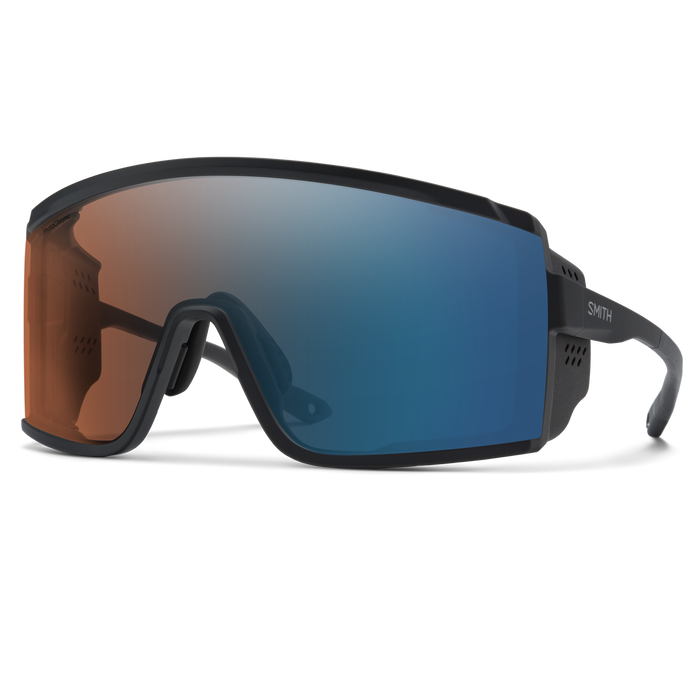
Fit: Large
Swappable Lenses: Yes
Lens Tech: Chromapop, photochromic available ($337)
Pros: Massive coverage, protective extras
Cons: Not for smaller faces, expensive
If you want the feel of goggles without wearing goggles, the Smith Pursuit Glacier Glasses may just be the sunglasses for you. Cody Townsend partnered with Smith Optics to design a futuristic pair of sunglasses that perform well in essentially every type of condition.
In order to really get a feel for these Pursuit Glacier Glasses, our tester tried them out at sea level as well as at the top of mountains to really get a feel for their performance. We found that the wraparound design worked well to block light from all angles, which was a huge plus while shredding. We found that they offered great eye protection for speed sports while remaining lighter than goggles. We also found that the photochromic lens worked well in a wide array of light conditions
Our only qualms with these glasses are that they don’t work well for folks with small faces. Also, changing lenses while on the go isn’t the easiest. If you’re someone who likes to regularly change their lenses, then these may not be the best pick. Read our full review of the Smith Pursuit here.
CHECK PRICE ON SMITH OPTICS CHECK PRICE ON Backcountry
Super Lightweight
Julbo Density ($255)
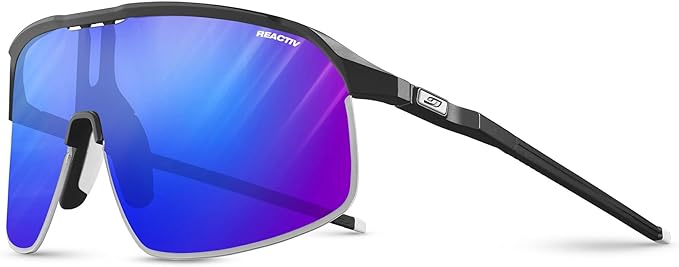
Fit: Large
Swappable Lenses: No
Lens Tech: Photochromic
Pros: Great coverage, lots of lens options with impressive photochromic ranges
Cons: Not the most durable
Julbo has been a surprisingly big player in the game of snowsports eyewear recently, thanks to some pretty incredible innovations. Their Aerospace vented goggles (which allow the lens to pull away from the frame for extra airflow to combat goggle fog) are a top choice for hard chargers and backcountry riders alike.
The innovations continue with their line of Reactiv lens tech. With varying levels of photochromic tints designed for a wide variety of light conditions (their most adaptable lens can transition from 4-87% VLT, an insane range), Julbo offers options that work to reduce glare, go completely clear for nighttime activities, or enhance contrast.
The Density is one of Julbo’s highest-coverage styles, with a wide wraparound lens (that’s vented to prevent fogging) and a super lightweight design. The thin arms extend from the top of the lens, with the bottom of the lens left open to increase breathability and reduce weight. The only downside to this lightweight design is that they aren’t the most durable of ski sunglasses. We haven’t encountered any issues yet, but if you’re someone who’s hard on their gear, the Julbo Rush, which sports a full frame, might be a better call for you.
CHECK PRICE ON BackcountryBest Budget Ski Sunglasses for Small Faces
Tifosi Sizzle ($40)
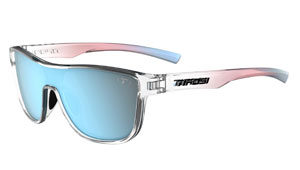
Fit: Small
Swappable Lenses: No
Lens Tech: UV protective
Pros: Stylish as anything
Cons: Don’t fit larger faces (try the Sanctum)
The Tifosi Sizzle sunglasses bring aprés-ski style in a slightly more protective-than-average frame. With a single, durable lens, they provide plenty of coverage for those with smaller faces. Our tester found them to fit a little small on his face, both in terms of looks and in the coverage provided, but they fit great and looked good on the female members of his family, who both have narrower faces. And their style cannot be denied. The pink mirrored colorway is boisterous and fun, and if you’re looking for a more toned-down look, there are plenty of other colorways to choose from. If you like the style of the Sizzle, but have a larger face, check out the big brother of these frames, the Tifosi Sanctum, which features the same design but scaled up for larger faces, at the same ridiculously low price point.
CHECK PRICE ON BackcountryUnique Pick
Ombraz Dolomite ($160)
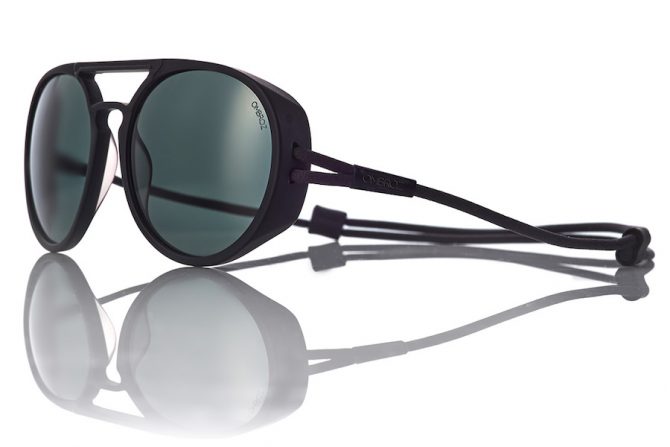
Fit: Medium
Swappable Lenses: No
Lens Tech: Zeiss lenses
Pros: Cool no-arm sunglasses idea
Cons: The string can be a little finicky with helmets
The Ombraz truly defies all categories when it comes to sunglasses. Not only do they have a piece of string instead of arms, but they also make damn good all-around action sports sunglasses. The string is an interesting concept. It works great for keeping the sunglasses on your face, is exceedingly comfortable, and makes the sunglasses very, very durable.
With a helmet on, it can be tough to get the sunglasses off your face when you want to (the brand recommends strapping your helmet on first, and putting the sunglasses on over it), but as far as a pair of uphillers for the backcountry go, these guys are great. The lens technology is similar to the Sunskis, with great polarization, but not the incredible definition-boosting of Smith’s ChromaPop or Oakley’s Prizm.
If you like the idea of the lack of arms, but prefer a shield-style pair of sunglasses, Ombraz just released their first shield-style, the Refugio. They also have a wide variety of frame shapes to choose from, as well as add-on nose protectors and side-shields for added coverage.
CHECK PRICE ON OMBRAZCult Style
Pit Viper 2000s ($100)
Fit: Medium
Swappable Lenses: No
Lens Tech: Polarized
Pros: Undeniable cachet
Cons: Looks over performance
No review of snowsports sunglasses would be complete without a pair of Pit Vipers. These iconically styled sunglasses radiate pure ski bum attitude, the kind of shades you don for a game of G.N.A.R. with friends and family. And they’re not just media hype, but pretty well-made sunglasses with a durable polarized lens and durable frame. That said, there’s no ski-specific lens tech, and the Flip Offs, mentioned above, have a winning aprés-style feature, so the Pit Viper 2000s don’t crack into our top picks.
CHECK PRICE ON EVO CHECK PRICE ON AMAZON

The POC Nivalis, sans side shields. Photo: Ryan Salm//The Inertia
Honorable Mentions
Though not mentioned here in this review, we’d also recommend the POC Aspire, which is more of a bike-oriented style of sunglasses, but with solid coverage, good style, great lens tech, and a comfortable fit.
The Flywheels from Smith are another great wrap-around option from one of the biggest names in the game, as are the Dragon Alliance Amped.
For more of a classic, Ski-Aviator style with some performance features (side shields), check out the POC Nivalis. Our tester found them to have a bit too narrow a fit for his face, which caused some issues with the side shields, so we recommend trying before you buy here. Another fun ski-aviator style, sans the side shields, is the Vallon Ski Aviator.
Pit Viper deserves a ski sunglasses article dedicated just to them. Above, we mention the Flip Offs and the 2000s, but Pit Viper has a wide array of other frame shapes that, while they might not be high on function, are very, very high on retro ski-bum style. Some of our favorites are the Slammers and the Exciters.
Another pair we’re testing this winter is the Sliders, a retro wrap-style pair of sunglasses with interchangeable lenses. We’ll update this review once we get out on the snow with them.
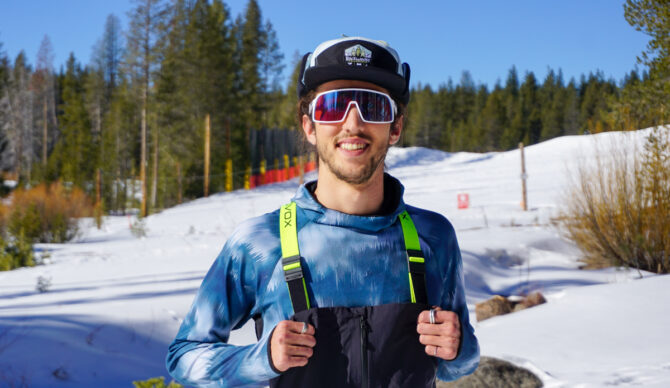
Our top pick, the Oakley Sutro, looks great both on and off the slopes. Photo: Ken Cox//The Inertia
Best Ski Sunglasses Comparison Table
| Sunglasses | Price (USD) | Fit | Swappable Lenses? | Lens Tech | Additional Features |
| Oakley Sutro | $203 | Large | No | Oakley Prizm | Different style options |
| POC Devour Glacial | $300 | Large | Yes | Zeiss lenses, POC Clarity | Swappable lenses |
| Smith Venture | $237 | Medium | No | Smith Chromapop | Retainer strap, photochromic available, removable side shields |
| Goodr Wrap G | $35 | Large | No | Polarized | rubberized pads on nose and temples |
| Sunski Terra | $98 | Medium | No | Polarized | Removable side-shields |
| Pit Viper Flip Offs | $100 | Medium/ large | No | Polarized | Flip-up lenses |
| Tifosi Moab | $80 | Large | Yes | Tifosi Clarion | Ventilation slits, photochromic available |
| Smith Wildcat | $247 | Medium | Yes | Smith Chromapop | Multisport design |
| Oakley Clifden | $297 | Medium/ small | No | Oakley Prizm | Lanyard, removable size shields |
| Smith Pursuit Glacier Glasses | $307 | Large | Yes | Smith Chromapop | Photochromic lens, wraparound design |
| Julbo Density | $255 | Large | No | Photochromic | Photochromic tint, wraparound lens |
| Tifosi Sizzle | $40 | Small | No | UV protective | Cheap |
| Ombraz Dolomite | $160 | Medium | No | Zeiss lenses | Armless sunglasses |
| Pit Viper 2000s | $100 | Medium | No | Polarized | Pit Viper street cred |

A small portion of the sunglasses we’ve tried for this review, from POC, Dragon, Smith, Anon, and Tifosi. Photo: Ryan Salm//The Inertia
How We Tested The Best Ski Sunglasses
We’ve been conducting testing of the best sunglasses for skiing for the past three years. Gear Editor Will Sileo leads our testing group. As a lifelong skier, beginner snowboarder, and connoisseur of aprés-style, he has a wide variety of perspectives to bring to the table, as well as an intimate and up-to-date knowledge of what’s out there on the market in terms of active performance eyewear.
The search for the best sunglasses for skiing and snowboarding began with a personal journey, a search for the confluence of optimum performance and maximum steeze both on and off the mountain, because no matter how hard you charge, you gotta look good while doing so, too. Over the past three years, Sileo and the gear team have tested over 20 different pairs of sunglasses, taking into account style, coverage, lens technology, fit, additional features, and more, with their top picks compiled here for your perusal. They tested these sunglasses in a variety of settings and conditions, from the skin track and deep backcountry face shots, to crisp bluebird mornings and slushy afternoon laps in “spring ski” conditions. Our testing location was the wide-ranging expanse of the North American West, from the backcountry of Whistler, Canada, to the steeps of Jackson Hole, Wyoming, and the snow globe that was Tahoe, California, during the 22/23 season.
Editor’s Note: This article was first published in January of 2022 after extensive testing the season before, and since then has been kept updated with the latest and greatest styles to hit the market. In December of 2024, we added six new styles and adjusted our rankings based on these new additions and continued testing. In our most recent update in December of 2025, we adjusted our rankings, removed one style that no longer represents our top picks, and added additional photos from our previous season of testing.

The Smith Venture sunglasses have side shields for extra coverage. Photo: Ella Boyd//The Inertia
Ski Sunglasses Buyer’s Guide
Which Features Matter for Ski Sunglasses?
The things we pay attention to when choosing a pair of sunglasses to ski in are coverage, lens technology, and of course, style. Coverage matters a lot, both for protecting your eyes and for blocking the wind during high-speed descents. Lens Technology is also important in what can be blindingly bright conditions out on the snow. Different levels of polarization, or special tints like Smith’s ChromaPop, can provide different benefits for various skiing conditions.
Style is a must because, of course, it is. Fit is another huge consideration, and we did our best to indicate where on the fit spectrum each pair of sunglasses lies. For reference, our tester’s face tends to fit medium/large-fit sunglasses the best, but everyone’s face is different, so we figured this was better expressed in words rather than a score based on how well the sunglasses fit my own face.

Shield-style ski sunglasses provide the most coverage, but can look a bit out of place in casual settings. Photo: Ryan Salm//The Inertia
What Are the Different Types of Ski Sunglasses?
Not all ski sunglasses were created equally. There are a few different styles that have their respective pros and cons.
Wrap-Around/Shield-Style Sunglasses are often designed with cycling and mountain biking in mind, but they also make incredible snowsports sunglasses with full coverage and solid ventilation (but not too much). They don’t tend to be the most stylish, but some (like the Pit Vipers and Oakley Sutro, above) have embraced the dorkiness and have turned it into a style of their own.
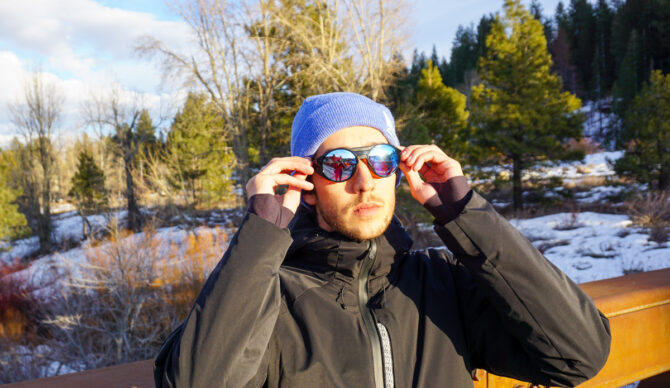
The Oakley Clifden sunglasses are shred-ready with clip-on side shields, a nose-piece, and a retainer strap. Photo: Nate Lemin//The Inertia
Glacier Glasses bring retro style but also have incredible coverage with their side shields. Traditional glacier glasses used to use fabric or leather side shields and super dark lenses for the ultimate protection in harsh alpine environments. Today, you can still find plenty of the old style of glacier glasses, but the most common “new wave” glacier glasses you’ll see out there today sport clip-on side shields for coverage when needed. Remove the side shields, and you have yourself a regular ‘ol pair of sunglasses, making these a great one-pair-for-everything style of sunglasses.
You won’t have as great a field of view as with shield-style glasses, but for high-light environments (glaciers, the tops of mountains, and the like), that can actually be a plus. Our favorite overall glacier glasses are the Smith Venture, but the Oakley Clifden is a pretty close runner-up. If you don’t want to shell out $250+ for sunglasses, the Sunski Terra provides an incredible value option at $98.
Aprés Sunglasses bring more of a laid-back, modern-style frame, meaning less coverage, but they make up for it with snow-specific tints, overly durable frames and lenses, and devilish good looks. Our favorite option here is the ridiculous Pit Viper Flip Offs, but really any silly pair of sunglasses is sure to get you a nod or two at the aprés-scene.

Lightweight ski sunglasses are great for the uphill. Photo: Ryan Salm//The Inertia
What Are the Best Ski Sunglasses Brands?
Basically every sunglasses company these days has some sort of ski-inspired design, but there are a few brands we’d like to call out for their expertise on the subject. First off, we have to give a nod to the legendary Smith brand. Known for their Chromapop lens technology and with a wide range of frames and lenses to choose from (photochromic lenses are now becoming a standard option across their line of ski sunglasses), there’s something for everyone here.
Oakley is another awesome choice, similar to Smith, the brand really knows what it’s doing when it comes to eyewear, has great lens tech (called Prizm), and lots of frames to choose from. POC also deserves a mention – while it doesn’t have quite as many frame options as Smith or Oakley, its sunglasses, made with Zeiss lenses, are top-tier. We’d consider the above to be the “big three” of ski sunglasses – they make the best on the market, but it’s worth noting you’ll have to pay a pretty penny for their styles.
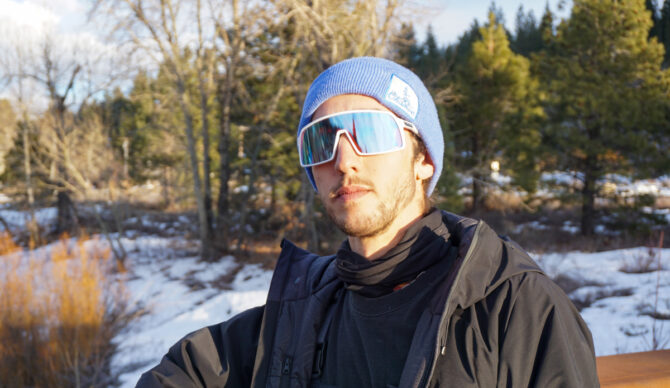
Oakley’s Sutro sunglasses are our top pick for this season. Photo: Nate Lemin//The Inertia
Some other awesome ski sunglasses brands are Goodr, Tifosi, and Sunski. Goodr has made a name for itself with dirt-cheap and stylish sunglasses. They’re $35 sunglasses, so don’t expect top-tier lens quality (though they are polarized), but if you’re the type to break or lose sunglasses, these would be a solid choice. Tifosi is another value-conscious brand, with more of a focus on cycling lens-tech and performance. With options that hover around $80, we’re huge fans of its photochromic lenses, which you’ll often find yourself shelling out extra for with the bigger brands.
Sunski’s Alpine Collection is also worth a big shout-out. Another value-focused brand with most options costing about $100, $150 for more premium metal-frame ski sunglasses, Sunski was a pioneer of the removable side-shield style back in 2020 with their Treeline sunglasses. Its options have expanded significantly since then, with a few different frame styles and various levels of lens tints (all polarized).
Finally, we’ve got to mention Pit Viper. The brand’s marketing is hilarious; its sunglasses, while not the highest-performing, are brash and stylish in a life-of-the-party sort of way, and there is a surprisingly wide variety of styles to choose from beyond the classic wrap-arounds they made their name with a couple of years ago.
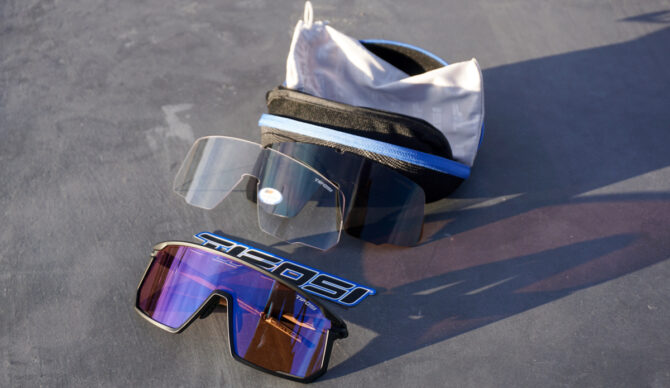
Tifosi’s Moab sunglasses either come with two additional lenses (low-light and clear) or one photochromic lens. Photo: Nate Lemin//The Inertia
Making Sense of VLT and Lens Technology for Ski Sunglasses
VLT stands for Visual Light Transmission. Basically, it’s the amount of outside light that the sunglass lenses allow to reach your eyeballs. Expressed in percentages, a lower percentage means less light allowed in, which, in layman’s terms, translates to a darker lens. For cloudy days and flat light, you’ll want a higher VLT percentage to let in as much light as possible (and contrast-enhancing tech like Smith’s ChromaPop, Oakley’s Prizm, and others can help, too).
For bluebird days or high-alpine glacial exploration, the lower the VLT, the better. To adapt to varied light conditions, some of the above sunglasses feature swappable lenses; others, like the Tifosi Sledge, use photochromic lenses that adapt to the light around them for the best tint.
Return to Comparison Table | Return to Top Picks
Editor’s Note: Want more coverage? Check out our guide to Snowboard Goggles. For more gear reviews and features on The Inertia, click here.

